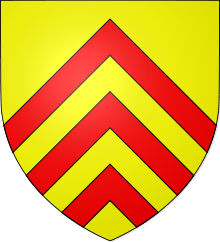Richard de Clare, 3rd Earl of Hertford
| Richard de Clare 3rd Earl of Hertford 6th Lord of Clare | |
|---|---|
|
Arms of the de Clare Family | |
| Hereditary | |
| Earl of Hereford Lord of Clare |
1173-1217 1173-1217 |
| Predecessor | Roger de Clare, 2nd Earl of Hertford |
| Successor | Gilbert de Clare |
| Spouse | Amice FitzWilliam, suo jure 4th Countess of Gloucester |
|
Issue | |
|
Titles and styles
6th Lord of Tonbridge 5th Lord of Cardigan | |
| Family | de Clare |
| Father | Roger de Clare, 2nd Earl of Hertford |
| Mother | Maud de St. Hillary |
| Born |
1153 Tonbridge Castle, Kent, England |
| Died | 1217 |
| Occupation | Peerage of England |
Richard de Clare, 3rd Earl of Hertford, 6th Lord of Clare, 6th lord of Tonbridge, 5th Lord of Cardigan (c. 1153–1217), was a powerful Norman nobleman with vast lands in England and Wales.
Career
Richard was the son of Roger de Clare, 2nd Earl of Hertford and Maud, daughter of James de St. Hillary.[1] More commonly known as the Earl of Clare, he had the majority of the Giffard estates from his ancestor, Rohese.[2] He was present at the coronations of King Richard I at Westminster, 3 September 1189, and King John on 27 May 1199. He was also present at the homage of King William of Scotland as English Earl of Huntingdon at Lincoln.
Marriage
He married (c. 1172) Amice FitzWilliam, 4th Countess of Gloucester (c. 1160–1220), second daughter, and co-heiress, of William Fitz Robert, 2nd Earl of Gloucester, and Hawise de Beaumont. Sometime before 1198, Earl Richard and his wife Amice were ordered to separate by the Pope on grounds of consanguinity. They separated for a time because of this order but apparently reconciled their marriage with the Pope later on.
Magna Carta
He sided with the Barons against King John, even though he had previously sworn peace with the King at Northampton, and his castle of Tonbridge was taken. He played a leading part in the negotiations for Magna Carta, being one of the twenty five sureties. On 9 November 1215, he was one of the commissioners on the part of the Barons to negotiate the peace with the King. In 1215, his lands in counties Cambridge, Norfolk, Suffolk and Essex were granted to Robert de Betun. He and his son were among the Barons excommunicated by the Pope in 1215. His own arms were: Or, three chevronels gules.
Family
Richard and Amice had children:
- Gilbert de Clare (ca. 1180 – 25 October 1230), 4th Earl of Hertford and 5th Earl of Gloucester, (or 1st Earl of Gloucester of new creation). Married in 1217 Isabel Marshal.
- Maud de Clare (ca. 1184–1213), married in 1206, Sir William de Braose, son of William de Braose and Maud de St. Valery.
- Richard de Clare (ca. 1184 – 4 Mar 1228, London)
- Mathilde, married Rhys Gryg son of Rhys ap Gruffydd, ruler of the kingdom of Deheubarth.
References
- ↑ George Edward Cokayne, The Complete Peerage of England Scotland Ireland Great Britain and the United Kingdom, Extant Extinct or Dormant, eds. H. A. Doubleday; Howard de Walden, Vol. V (London: The St. Catherine Press, Ltd., 1926), p. 736
- ↑ I. J. Sanders, English Baronies: A Study of Their Origin and Descent 1086–1327) (Oxford: The Clarendon Press, 1963), pp. 34, 62
| Preceded by Roger de Clare, 2nd Earl of Hertford |
Earl of Hertford 1173–1217 |
Succeeded by Gilbert de Clare, 4th Earl of Hertford |
